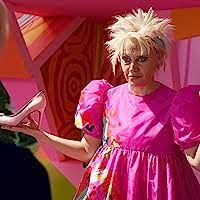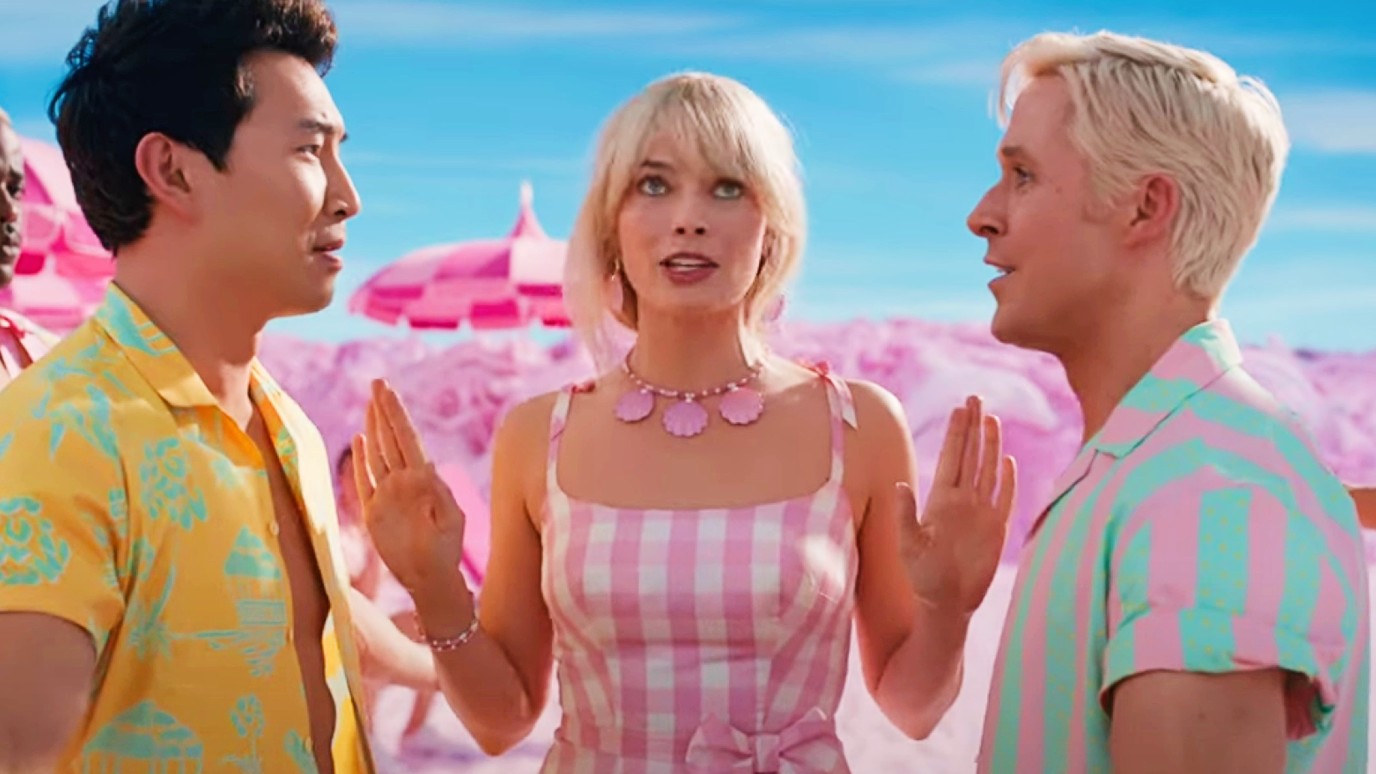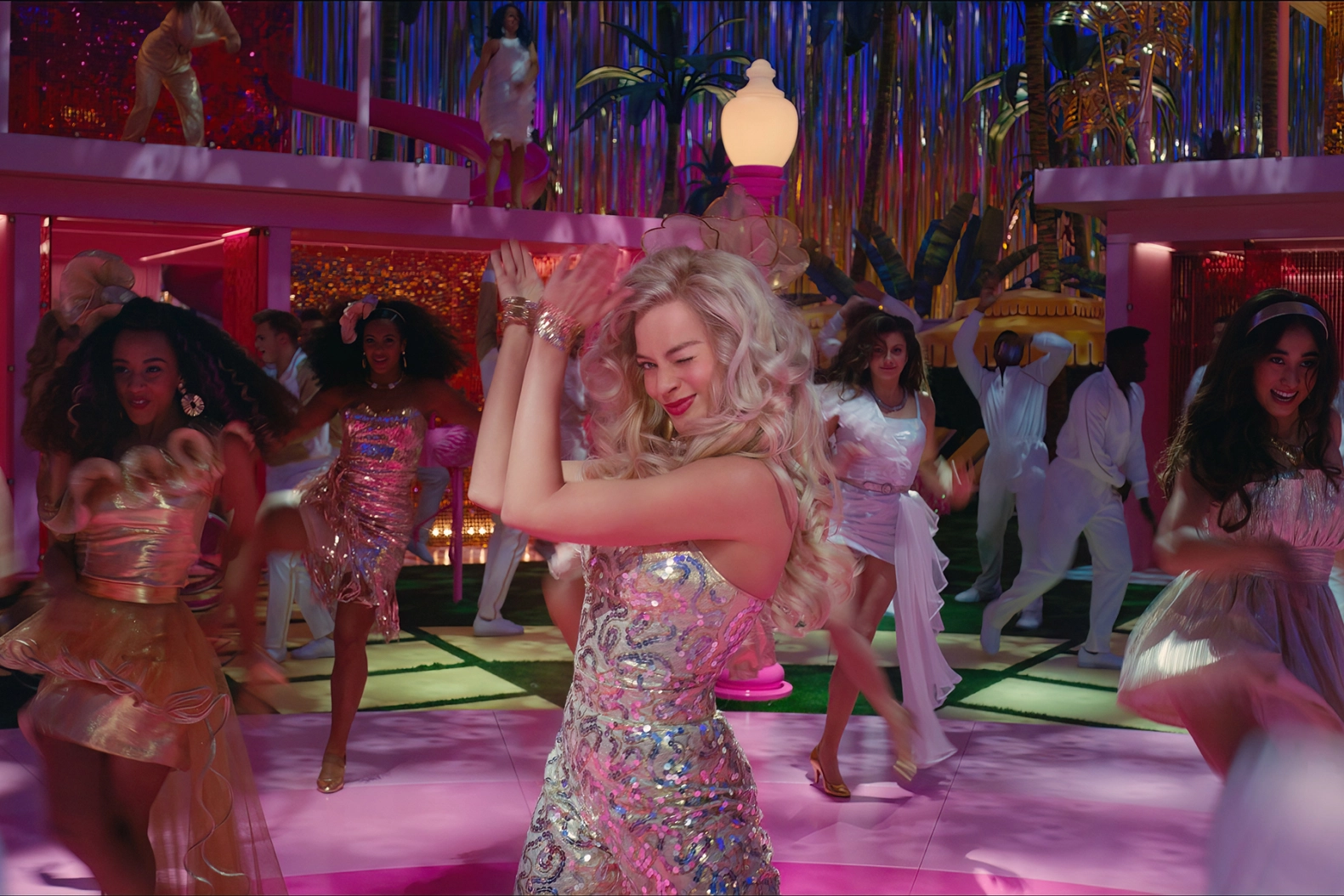“I just don’t know what to do with myself….” Burt Bacharach / Hal David, 1962
I’m not sure if Barbie is a new kind of cinema, but it’s not the sort of film we’re accustomed to seeing in wide theatrical release on the biggest screens and dressed in the highest of high-gloss Hollywood production values. In fact, it’s a form of entertainment we’re far more likely to have encountered in a theatre—meaning, the stage (and rarely, if at all, musical theatre). And although Barbie is many things—including simply a continuation of Greta Gerwig’s very personal cinema of self-actualization; and yes—a commercial advertisement for Mattel and the Barbie doll by way of cultural and political (more than slightly intertextual) deconstruction (not the sort of advertising vehicle we’re accustomed to seeing from Mattel, nor likely to be seeing again)—it is also very much a musical. But more importantly, it’s a kind of enchantment.
Barbie may be far from perfect in formal or dramatic terms (though even its imperfections seem willful, penetrating the Mattel/Barbie high gloss (all that pink!), another aspect of Gerwig’s very personal imprint); but it meets the cultural moment in full—sweeping up the full spectrum of political, cultural and existential anxieties in its wake. Any Hollywood movie (especially a Hollywood movie-musical) can create a parallel universe, defy the space-time continuum and the laws of physics. Barbie does all this while turning every facet of the film story, its frame, and physical production inside out. What it is a kind of meta-cinema. It is a kind of pageant of its mannequin-heroine-goddess—her apotheosis, and her return to mortal incarnation, with the heroine simultaneously acting out the drama and glorification of her manufactured perfection and puncturing it. But Barbie (the doll, too, as engaged by many girls’ play over the last half-century) embodies many different aspects, personalities, aspirations. Any number of personal destinies may evolve—or devolve. We see several distinct aspects of this—some at Mattel’s own unintentional instigation (e.g., variations in the standard model, auxiliary and supporting characters, etc.).
In a sense, Gerwig uses Barbie herself (or more specifically, Barbie, the idea) as the singular meta-instrumentality—simply by inferring an empathic connection between this pink dusted, glitter-bombed, vacuum-sealed Hollywood sound-stage world, and the world where actual children play with actual Barbie dolls (Barbie, the product).
‘Weird Barbie’ (Kate McKinnon) is yet another manifestation of this—but a critical one, in that she performs it within this domain of subconscious and unconscious fantasy and radical empathy. Weird Barbie doesn’t entirely understand this phenomenon herself; but she doesn’t have to—she manifests it with her idiosyncratic metamorphosis and her own isolation within this hermetic domain. We recognize this Barbie, too. You can usually find at least one shoved in back of just about every other girl’s closet or stash of toys—the ‘assisted readymade’ Barbie someone’s slightly bored, frustrated, fed-up or otherwise alienated sister, daughter, or niece took a Sharpie, pens and crayons, and pair of scissors to; and we can imagine the scenarios they probably invented to accompany them: the Barbie that took a left turn (maybe even politically), that got kicked off (or just quit) the cheerleading squad in spite of her flawless splits, the one that rebelled, that went punk, that dropped into a death metal club, or an S&M dungeon and was intrigued; the Barbie that dropped out, blew off to India or Africa (that would make for some intriguing wardrobe hacks), and suddenly turned back up stateside at MIT working on an experimental vaccine or AI (from biker leathers to white labcoats—it happens).
But Gerwig is tapping into something still larger here—not simply a cultural pulse, l’air du temps, the Zeitgeist (though there’s all that, too), but a collective unconscious as acted out in a kind of overlapping real and fantasy world spectacle. I wouldn’t compare it directly to something like Shakespeare’s A Midsummer Night’s Dream (which some critics put forward alongside Hamlet as another, almost airtight ‘metaplay’), but Barbieland is a kind of fairy domain, and Barbie—not a ‘fairy’ exactly, but a kind of ‘changeling’ (again, quite distinct from the AMND variety), a chameleon. They’re here in the ‘real world’, too, after all. It’s a kind of transference—and Gerwig hints at it from the onset with her pastiche of Stanley Kubrick’s Strauss-transfigured ‘Tools’ prelude to 2001: A Space Odyssey (M-G-M 1968), accompanied by Helen Mirren’s sardonically hilarious narration. (I suppose you would have to call it “Dolls.”) And simply transfer—or transition. (Consider the trajectory that film sets its accidental hero on.)
One thing almost every successful musical theatrical (or film) production achieves is a kind of neutralizing of the background noise or hum that happens to some extent in any public setting or for that matter electronic transmission. In Gerwig’s Barbie, from very early in the film, it’s almost as if instead of noise or hum, a low-level anxiety or apprehension seeps beneath every scene, and threads among the musical elements—from dance extravaganzas (Dua Lipa’s “Dance the Night”) to elegiac reveries like Billie Eilish’s “What Was I Made For?”), magnifying it in a way that almost sinks into your skin. Our entire conception of this ‘packaged’ environment seems predicated on the notion of sealing it (or any consequential danger or even risk) off; yet here it is, ‘free-floating’ or free-falling—take your pick—from roofs, closets, classrooms, cubicles, toy boxes.
Somehow this angst, this dread, this anxiety has insinuated itself into the Dream House of the quintessential, the iconic, ‘Stereotypical’—blonde, blue-eyed, classic physics-and-physiology defying proportions—Barbie (Margot Robbie). But this time it’s not coming from some bored, frustrated, rebellious, angry or alienated girl—but the mother of one (America Ferrera) who just happens to work as an administrative assistant at the white-hot center of everything Barbie, the Mattel CEO’s office. As the chief executives and corporate officers confab about a possible fugitive Barbie with a crisis threatening to break down this air seal between the world of Barbie and our world of barbarians (a stand-in for the current existential cultural conflict, to say nothing of our biosphere on the brink of a death spiral), Gloria (Ferrera) sits outside a conference room doodling an imaginary ‘Unrelenting Thoughts of Death’ Barbie and similarly existentially angst-ridden and anhedonic models.
How do you accidentally step into a cold shower when the ‘shower’ isn’t even real? How exactly do you come down to earth when you can no longer defy gravity? These are Stereotypical Barbie’s first rough steps as—still unaware anything is seriously ‘wrong’—she begins her transition from ‘perfect-Barbie-hood’ to actual personhood—paralleling the earthly model in which we chisel out our own personhoods within physical, social and cultural gravitational and magnetic fields.

Weird Barbie (Kate McKinnon)
Courtesy Warner Bros.
Barbie’s pilgrimage to Weird Barbie’s slightly twisted (but niftily equipped) ‘dream house’ is a critical stop on this long pink highway—where she’s asked to choose between two—well, not ‘grails’ exactly (of course they’re shoes), but a kind of dual instrument and expression of role and self-acceptance. Weird Barbie already grasps the painful truth: self-acceptance is not necessarily the imagined or pre-conceived aesthetic ideal. Gerwig isn’t exactly fashioning a Rohmer-esque ‘moral tale’ here, but she uses an aesthetic domain to illuminate a moral universe. I’m still not sure about the mandatory roller-blades here—whether keeping her (and, yes, Ken) on the ‘straight-and-narrow’ trajectory back to the sources of her fracturing stereotype, or simply facilitating the not-so-perfect ‘blend-in’ transition to the so-called ‘real world’ on the Venice Beach boardwalk.
With Ken (Ryan Gosling) in the back seat, it gets complicated before they’re even half-way down the pink brick road to that scary crazy fantasy corner of the world some of us actually call home. Gerwig isn’t just breaking a fourth wall here; civilization’s trappings—its dramas and rituals—aside, we’re in the wilds here.
This continuous re-definition and revision of personhood involves reciprocal observation and scrutiny, an acceptance of pain and (at least occasionally) its infliction. Again, we have a little ceremony: a post-arrest booking at a police station, accompanied by a small tidbit of useful ‘education’—that leads our heroine and (for now anyway) sidekick to a ceremony they’re already familiar with: costume change. Alas they’re still blissfully unaware of the retail part of that ceremony in the late-capitalist real world—though, as we will see under their flawless plastic/skin, they may they have some intimation of it. So it’s back to the precinct station and then on to the Santa Monica Courthouse where, not surprisingly, our heroine needs a time-out on every level, because in addition to developing a sense of identity, she’s also discovering time.
The external gaze—her own as well as others’—leads her to the next level of self-awareness: irony. Naturally she goes to an actual school to learn this—by way of a group of disaffected (and long past Barbie) schoolgirls—bringing her still closer to the source of her torment (though also, conceivably, liberation). And while Barbie is learning everything she isn’t in the real world (a scene which will later be answered by Gloria, summarizing everything a woman is supposed to be), Ken is discovering the not-so-hidden joys of patriarchy—at least to those ‘Kens’ who might become patriarchs. Also horses.
Barbie’s ‘descent into the underworld’ turns out (appropriately enough) to be an express elevator to the top floor of a Century City high-rise (though Mattel is actually headquartered in El Segundo). It turns out to be not merely an ‘underworld’, but also a kind of infinite after-world. Time and space bend here, too—a foretaste of Barbie’s ultimate cross-over to the country she’s just discovered and the undiscovered countries that lay beyond. There are Kubrick quotations here, too—including a ghost kitchen where the original Barbie creator, Ruth Handler’s ghost (Rhea Perlman) offers the now fugitive Barbie tea before her flight back to Barbie World.) But of course Barbie must be tempted and tested—retracing her ‘origin story’ back to ‘the box’—with all the accessories and wardrobe essentials the stereotypical Barbie needs, neatly sealed off from the world of dirt and dust outside the plastic window.

Barbie (Margot Robbie) mediates the ‘Beach-Off’ between the Kens (Ryan Gosling and Simu Liu)
Courtesy Warner Bros.
While Barbie is retracing her roots, Ken, master of all things Beach, is discovering a few new things to master. He’s also learning what it means to be seen—unencumbered by any serious awareness of just how he might be seen. But here’s the thing—Shark, Jet, Barracuda, Sting Ray, or dude on a horse—this Ken can’t seem to catch a wave, a predicament Gerwig orchestrates elegantly in the first reel (which may owe something to the “Seahaven” crafted by Peter Weir, Andrew Niccol, et al. for The Truman Show (Paramount, 1998)). This is a Ken who’s “actually not sure” about what he wants from Barbie (where have we heard that before?), nor is he exactly sure of what he wants from himself. Back in Barbieland, Ken builds himself a jury-rigged man-cave fit for a no-jury-required patriarchal fantasyland, all but acting out Susan Faludi’s Backlash (1991) and Stiffed (1999) in the process. (Jessica Bennett’s invitation to Susan Faludi to weigh in on these parallels in last Sunday’s New York Times Opinion section was a stroke of genius.)
Undoing Beach Ken’s and his Ken-bros’ mischief requires craft and cunning—qualities the Barbies and their real world-schooled allies (Ferrera and Ariana Greenblatt—who plays her daughter, Sasha) have in abundance. It turns out that upholding (and saving) a republic—even a Barbie republic—is a fraught business. (Gee, where are we seeing that lately besides every screen and metro daily front page in our ‘real-world’ United States?) The Kens’ hobby-horse republic, which seems to stand for nothing more than their capricious dominance, beer-buddy leisure and relegation of the Barbies to handmaiden status might just be a funhouse mirror version of the real not-so-post-patriarchal world where, as Ferrera’s Gloria sums up, women pretty much have to be everything to everyone at exactly the right time. You have to “always be extraordinary”; “always looking out for other people”; “answer for men’s bad behavior, which is insane”; “never show off, never fail”; but “somehow we’re always doing it wrong.” (I can’t replicate the entire speech here, but it would almost be worth seeing the picture just to see that scene play again. I’m not sure Betty Friedan said it much better in The Feminine Mystique.)
The speech is a litany of contradictions, which occasionally strike ambiguous, almost discordant notes (“Never forget that the system is rigged.” The patriarchy? Late capitalist corporate America? The government? The ‘Ruling Class’?—no, not the 1972 Peter Medak directed movie—though who knows? The film’s central character lives in more than one world—conceivably as many as three.) Having successfully accompanied Barbie back to Barbieland, is Gloria playing devil’s advocate? Insisting there is no point, no advantage to crossing back over to the mortal domain where Stereotypical Barbie might well “stand out,” but better not “get out of line”?
We take her point (do we ever!); but somehow it all seems bound up in the insupportable, impossible questions of life itself. Gerwig and her co-writer (and regular creative collaborator), Noah Baumbach seem continually drawn to these questions and situations: the unstable, tentative, contradictory, near-paradoxical, and ambiguity-suffused conditions and conundrums of human life and our emotional, quasi-romantic attachments to and within it. It’s a terrain she (and they) share with any number of cinematic and theatrical artists (not just Shakespeare). With an emphasis on the romantic and familial aspects of this social and emotion quicksand—borrowing directly from Stephen Sondheim—Baumbach has his alter-ego, Charlie (Adam Driver) spell out the contradictions explicitly in an impassioned rendition of “Being Alive” (from Sondheim’s 1970 Broadway musical, Company) in his 2019 film, Marriage Story. Gerwig’s emotionally sprawling 2017 film, Lady Bird (A24/Universal/Focus) is riddled with these questions—they’re practically a connective scar tissue through the film.
Barbie, the character, stands out in another way that connects her with other unseen populations in the human ‘real’ world. ‘Stereotype’ or no, she begins her journey a cipher, an anonymous (albeit distinctive) figure in a sea of similarly uprooted figures voyaging from one nowhere to the next anywhere—desperate for a place to physically exist much less project a self. we carry our fully (or not-so-fully) realized selves, pretty much alone.
Barbie’s (or anyone’s) journey to personhood requires more than a little grit. The modeling, molding and ‘chiseling’ that goes into it is real. It’s not just editing the ‘doll’, the mannequin, the persona to fit an audience—though as Ferrera’s Gloria reminds us, there’s that, too. Humans must jettison (or maybe just recycle) a lot of baggage. It’s as if we never stop running, defending, prosecuting. There are losses, there is triage; we walk into our dreams and we walk out of or simply away from them before that “one ending,” as Ruth Handler’s ghost reminds Barbie, we all have to face. We don’t take any of it with us. Self-acceptance is as awful and crushing and shattering as it can be exalting and empowering. There will always be those of us who never quite feel we’re ‘enough’ (yet also feel as if we’re a bit ‘too much’).
Gerwig doesn’t leave Barbie at a ‘promised land’, as she might have in an actual M-G-M musical of 60 years ago (which its’s quite clear she would have no trouble executing)—though Santa Monica isn’t the worst place to start over. But it’s a moment of reassurance that arrives at a moment when we have lost any sense of assurance or certainty. Sometimes it’s exhilarating just to show up and be acknowledged as the person you dared to think you might actually be.
Barbie (Warner Bros./Mattel) directed by Greta Gerwig, written by Greta Gerwig and Noah Baumbach — is in wide release — in theatres everywhere in Los Angeles and the U.S.

